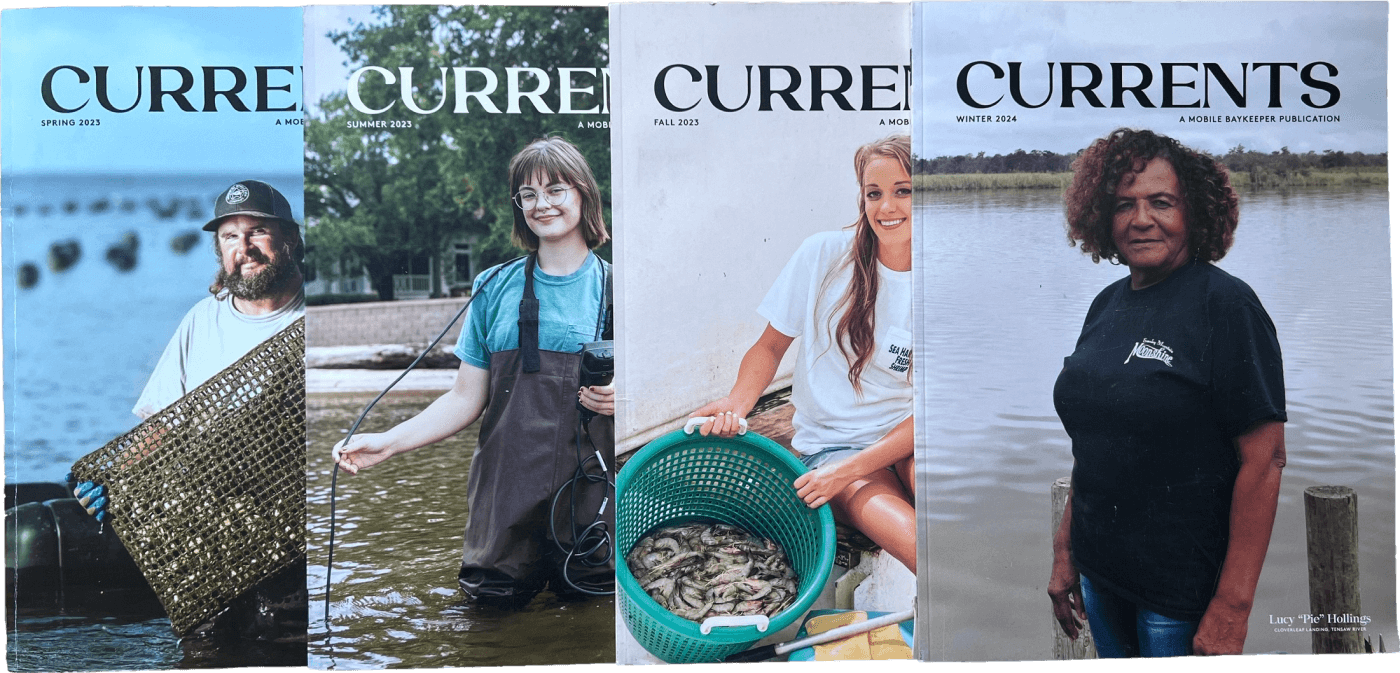
This article is from Mobile Baykeeper’s print quarterly, CURRENTS. The magazine is mailed to active members who have given more than $50 in 2023. To get on the magazine’s mailing list, donate here.
by Josh Tolbert
Dog River covers an expanse of 55,000 acres and catches runoff from a large portion of the City of Mobile and Mobile County. Everything from “The Loop” to the Mobile Regional Airport, all the way down to parts of Theodore, drains into Dog River. When it rains, the runoff from the farms, cul-de-sacs, and parking lots in the watershed makes its way into Dog River, picking up contaminants along the way. There are also old sewer pipes and leaky septic tanks that become inundated with water and spill untreated wastewater into those same streets and drains which flow into the river.
Mobile Baykeeper, in partnership with the University of South Alabama, is working to improve water quality in Dog River through microbial source-tracking. The goal of this project is to identify major sources of bacteria, which can impact swimming safety in the area.
In 2020 and 2021, weekly testing for Enterococcus (fecal bacteria indicator) in Dog River revealed a fail rate of approximately 50 percent for a “safe-to-swim” status. Although Dog River is classified by the state as having water quality which is only suitable for the survival of wildlife and not supportive for recreational means, we argue that current and historical use should create a means for a waterbody’s quality to improve and meet actual uses.
Dog River is regularly frequented by fishermen, boaters, jet skiers, swimmers, and kayakers. So no matter how often the river supports safe bacteria levels for swimming, we need to make improvements to meet the community’s further needs of this waterway and others in the Bay area.
Bacteria levels are one of the biggest contributors to water pollution. One reason why bacteria isn’t as synonymous to swim safety as bad weather or waterway hazards is due to the fact that it isn’t always visible. For example, when I was helping with sample collection for this study, it was a beautiful day out.There were lots of people on the water and I would’ve wanted to join them if I hadn’t been working.
However, once we got back to the lab to process and saw the bacteria results in comparison to those from the same area after a dry spell (100-200 times higher), I realized there is more to swim safety than meets the eye. Our “wet weather” results were noticeably elevated from dry conditions, even though the water didn’t seem particularly dirty or polluted. People can see an oil sheen on the water’s surface, or spot plastics and trash floating nearby, but bacterial inputs can often be harder to visually detect.
Mobile Baykeeper routinely monitors fecal bacteria levels around the Mobile Bay area to inform the public; but thanks to funding from the Stephens Foundation, we are working to not only keep you informed on where to swim today, but to make those places safer to swim tomorrow. By identifying bacteria sources as human or animal-based and finding out where input is most extensive, we can better develop preventative campaigns for the Dog River watershed.
So, what does a source tracking day look like in Dog River? We start by taking samples at the beginning of the river where Eslava Creek and Bolton Branch flow in and work downstream to sample at nine other tributary points. We continue working downstream all the way to where Dog River meets Mobile Bay. We take bacteria samples, record data like water temperature and dissolved oxygen levels, and collect water which will be analyzed for DNA (this helps us answer the question of “whose poop is it?”).
These results are used to “paint a picture” of fecal bacterial pollution in the entire watershed. This will ultimately help us target our bacteria runoff mitigation efforts in a more precise and accurate way by understanding the sources and relative contributions to anticipate appropriate interventions. We believe the microbial source-tracking project in Dog River is necessary to revive the coastal waters and tributaries of the Mobile Bay Watershed.
